A Paipo Interview with Terry Wilson
February 1, 2021 - Fareham, Hampshire, England
An e-Mail Interview by Bob Green
The first British surfboard company was established in 1965. Others
followed, including Terry Wilson's Harmony Surfboards based in Devon.
What was different about Terry was his experimentation with materials
and construction methods. He also made a range of fiberglass
bellyboards, mass produced, as well as custom boards.
Pictured to the right is Terry Wilson, ca. 2021.
Photo by Neil Wilson.
|
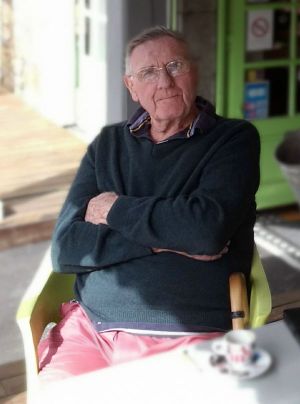 |
|
1. I believe your background was as an engineer?
When I came out of the Army, my National Service, I looked about for a job. Most seemed a bit tedious
to me but engineering had some attraction—but I was what?—20 years old
(past it really), and apprenticeships for 20-year-olds were hard to
find. So get a job, anything, in engineering and 3 nights or so a week,
Night School at the Tech. Happened back in the mid- to late-1950s.
2. When did you first get interested in surfing?
Rugby gave me up in the 1960s, I didn't mend by the next
Saturday every time, so needed something to do. About this time we had
emigrated from Essex to Cornwall and the guy we had bought our cottage
from was surfing and took us to Widemouth Bay and I guess lent me a
board. Boards were relatively expensive "so let's make one." Polystyrene
foam, some glass with a glue that didn't melt the foam, and I had a board,
albeit just on 8 ft. long. An 8 ft. was regarded as a short board, unknown to
me at the time, a bit radical apparently.
3. I heard your first business started from a garage at Braunton. When was this?
No, I didn't start my first business from our garage. For
many years it was all very non-commercial. I made boards because I
enjoyed doing so, and could experiment as I felt things were worth
trying. Growing sons needed bellyboards and the elder two needed stand-up
boards. Shapes changed frequently in those days—if they looked
promising then let's try it. I needed to sell off some boards, as
storage soon becomes a mega problem. I found that having a label on the
boards helped to sell them, so TAU come into being.
[Editor's Note: Braunton, England, is the home of the Museum of British Surfing.]
4. When did you move to Willingcott?
Our move to Willingcott was in 1983. Memorable. We lived in
Braunton from 1971. We decided to do the house move, we had 4 strapping
lads, do
it in what? 2 hours, no probs.
5. Where did the idea for making bellyboards come from? Did you have a background in riding them?
I spent a lot of time driving around as I was assigned new
factories to overlook, in for some weeks and was thinking around things
to do during the Summers. Yes, I could make surfboards, but it seemed
to me that adults had all the boards, good designs and spray designs,
Kids surely would like something similar but of their own size and price
would need to be a consideration. So it has to look like a full-size
board, good colors and a spray design.
Neil Wilson in 1976 and at Lynmouth in 1987.
|
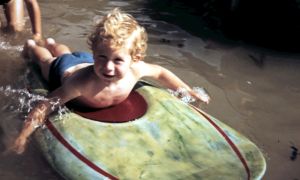
|
|
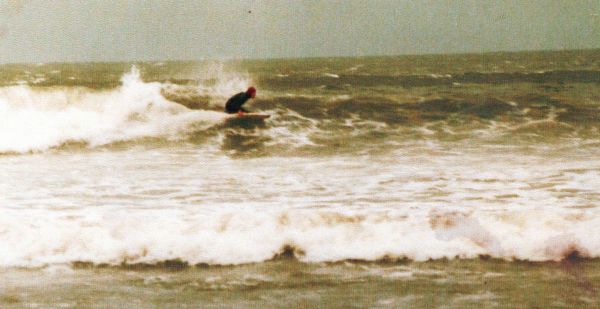
|
Photo courtesy of Neil Wilson.
6. Was the molded Mini Board the first bellyboard that you made? When was this? Can you describe their construction?
Yes, the boards were molded, in order to meet some of the requirements.
I had made lots of bodyboards, paipo boards I suppose, before I dreamt
up the "Mini Board" which must have been in the 1970s.
Mini Board
|
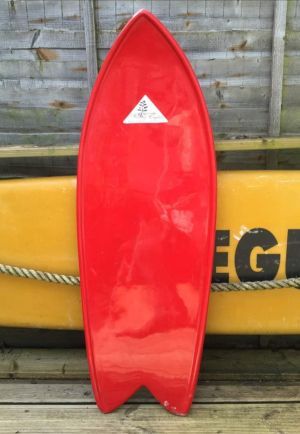
|
|
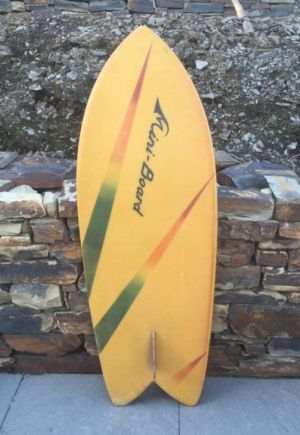
|
Photo courtesy of Neil Wilson.
How did you build the molds? What was involved in building these molded boards?
Molds? I had made one or two molds before. It was pretty well standard
stuff, custom make the "plugs" or Masters and polish, like polish 'em.
I incorporated a rib around the rails, I felt the boards needed
longitudinal strengthening. Take off the molds and strengthen, a
wooden "A" frame helpful then polish molds, more. Making the boards,
usual glass reinforced polyester (GRP) processes, gel coat, but we used to put designs into that.
Chopped strand Matt layup, trim, we then varied things by letting
polyurethane foam sheet into the bottoms of the boards, spray designs
and glass up, polish. Job done.
7. Was the Bullet the next design? When did you start making them and how did they differ from a Mini Board?
The molded "Bullet" came along later as I was looking for a bellyboard with
a bit more flotation. We were being asked for something for parents to
surf with when their kids had Mini Boards. Twin fins put some control
into the board. They were good fun boards. I never tried kneeboarding
them for some reason, bit too small perhaps.
Tau Bullet
|
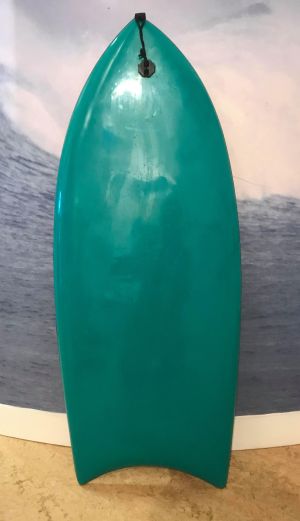
|
|
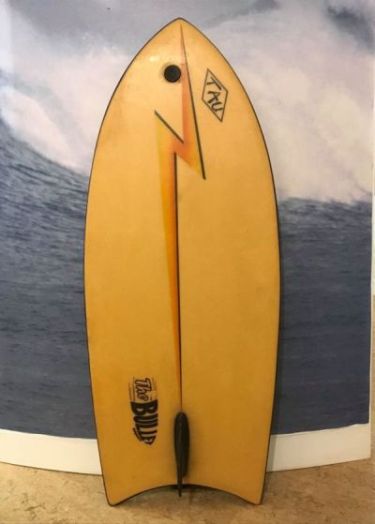
|
Photos courtesy of Charlie Spurr and the Museum of British Surfing.
8. Where did the name Tau come from?
TAU brand name? It's a standard engineering term for torque, "a turning moment." It's also the letter 'T'
in Greek.
9. Besides more flotation how did the Bullet differ from the Mini Board? Do you recall the dimensions of these boards?
Bullets differ? Yes they did, we originally tried to do
them a la Minis, not good. So we turned them to "Pop outs." Made top
and bottom molds, bog standard GRP laminations. We then foam filled
the boards. If you slip up on quantities for some reason, misread
perhaps, or hot summers day. Pressures can get pretty high doing this,
which is when the clamps fire around the workshop. Leg it.
Molded Bullet bellyboards which were hollow with a drain plug
and later foam filled. They had a fin box for a single-fin or twin-fin
set up.
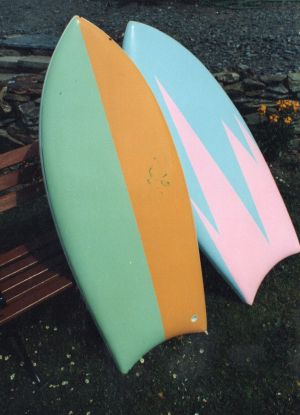
Photo courtesy of Neil Wilson.
10. When did the Harmony label start? What can you tell me about Harmony boards?
Harmony? Started somewhere in the mid- to early-1980s, by which time
the
whole family surfed. Of course, we used Harmony boards. The boards were
made for the local beach and we tried hard to cater for locals, but
also
Woolacombe was a family holiday center, and they were the people we
tried to attend to and sold boards to. We occasionally made tailored
custom boards when asked, from kneeboards, to down the line large wave
boards, quite unsuitable but asked for I remember. We tended to make
more Mini mals than most others, but I surfed kneeboards and also
longboards. We made a range of pop-out molded boards and surfskis, and
at later times we made custom boards with wood veneers. Bellyboards
from styrene foam and etherfoam—sometimes with slick
bottoms and fins.
Harmony logo and Tube News advert, January 1987
|
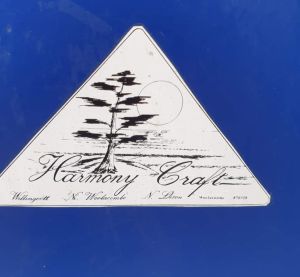
|
|
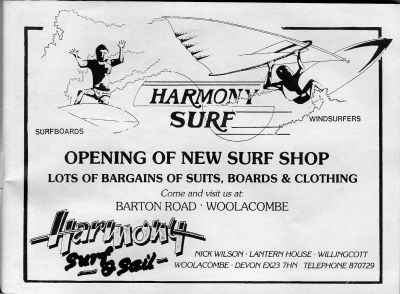
|
Photo courtesy of Neil Wilson.
11. Who were some of the people you remember working for you? Did your sons get very involved in making boards?
Who worked for me? Firstly, my sons. Our eldest did one or
two all night sessions, in fact several, when we were pushed. And both
Neil and Paul who are a bit arty did arty art work on the custom
boards. Phil was a bit good veneer laminating, and enjoyed doing it.
Careful work. When it all first started as TAU Surf a friend of mine
let me use his Deep Litter House. I think previous owners of his
business had had chickens or porkers in there. All nice and clean
during our time. One chap who worked there, Colin, a model maker, my
word he needed little prompting to produce such very good products.
Later, Tim Jones worked with us; he also ran a surf school using our
longboards, pop outs and wetsuits. Tim last heard of running a surf
school in Lanzarote. Such a nice helpful chap and very good surfer.
Often to be found with our 10 ft. Bilbo, a monster board but a real
cruiser, it used to have a little trick up it's sleeve. It had very
soft round rails, when cruising it would suddenly tuck a rail under,
kept you awake.
Booklet images courtesy
of courtesy of Charlie Spurr and the Museum of British Surfing.
12. What did you enjoy about these boards? What sort of waves were they made for?
Yes, we all rode our boards, mainly at Woolacombe but also Croyde in
North Devon was a very good beach to surf. We surfed any beach if we
finished early delivering to Cornwall or wherever then we used to surf
what beach we were near. It would be nice to be able to do that
nowadays. Hey Ho!
Nick Wilson inside a Woolacombe tube and performing a bottom turn.
|
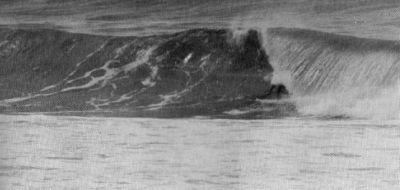
|
|
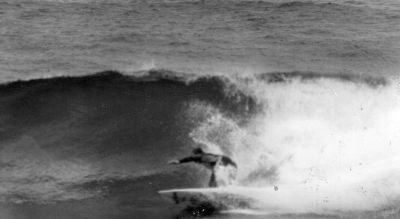
|
Photo courtesy of Jason Fill.
13. Was the market mostly local? How many of these boards do you
estimate were sold over the years? Did you make many custom boards?
We were running a surf shop in the 1980s, mainly with visitors in mind it
has to be said, but very aware of the local trading, some of our boards
are still in ownership of local people. One chap has several of our
boards still, and the veneer longboard is still in use along the coast
from here. The occasional Mini-Board still comes up for sale. How many
did we make? Cripes! Blue styrene foam—hundreds, yes that many.
Etherfoam—lots when we worked all night gluing up, we would come out
of the workshop two"'very happy Chappies." I would estimate we made
something in the order of 2 to 4 custom boards each week in the
summers.
1988 Harmony custom boards.
|
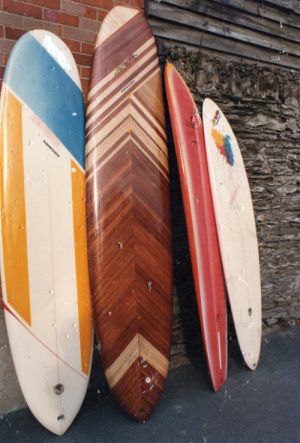
|
|
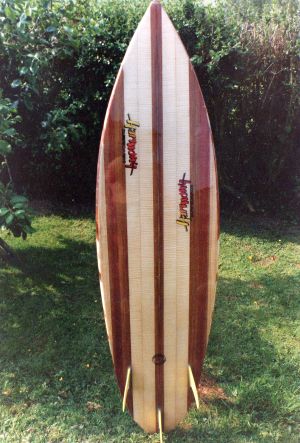
|
Photo courtesy of Neil Wilson.
14. How did engineering influence your board making?
Yes, I suppose it must have, particularly perhaps with the pop-out
boards, putting some strengthening ribs into the assembly maybe. I
guess you just do what seems to be right for what you are producing.
15. How did your design and board making ideas evolve over time? I'd
also be interested to hear about any experimental ideas or innovations,
such as the honeycomb core board that you made?
Did I consciously make changes for those reasons or just that, it
looked like it may work better. The Mini Boards were I guess a
considered concept, designed to do a job with a group of customers in
mind. I like to think my use of wood veneers was structurally sound,
and we thought they looked good as well. Now every man and his dog use
it in some form or another.
Honeycomb, that rattles a few memories. It seems to have come into it's
own in the last few years. I looked at that about the time I began
using wood veneers, tried it for a while but not happy with what I was
getting. Should have looked at it further perhaps.
What was the honeycomb made from? How did you use wood veneers?
Honeycomb. Dabbled with it, the one I first tried was made from a
lightweight cardboard, there were later wood veneer editions, which
would have suited better. This was about the time I was trying veneers.
Devil's own job to get the core to do what I wanted it to do. Thinking
back, I think balsa would have been a much more suitable material. Got
there in the end but not totally happy, so didn't pursue.
16. When did you start making ethafoam boards? What were they like?
Ethafoam [see note 1], we started making them when Boogie Boards
reached the UK. Supplies became difficult to obtain and only available
to the larger shops. A little bit of searching for materials and not
too hard to make something very similar but not a copy of course,
cheaper to make than buy as well. Used to make some with a hard slick
bottom and twin fins, they went very well, but different style of
surfing, our customers were into drop knee surfing really.
A range of boards from soft board belly boards, custom mini mals and
wood veneer mini mals. The artwork on the custom was air brushed by
hand.

Photo courtesy of Neil Wilson.
17. When did you stop making bellyboards? Did you continue making other boards?
I stopped making bellyboards somewhere around the 1990s. We
were thinking of moving upcountry, grandchildren were coming on the
scene, surfboards? No, I still made some boards around that time all
customs. I guess about 3 or 4 years ago I was asked to make some balsa
boards. That was very enjoyable, made a couple of "Pig Boards" but with
tri-fins, I think best with a big deep Kanga single-fin, but then I'm a
conservative old senile nowadays.
18. Based on your experience what do you reckon a modern bellyboard would like?
A modern bellyboard? Wow! Materials haven't changed too
much, debate epoxy or GRP. Shape, have to look into that, still
probably go back to my Mini Board and start from them, a little wider I
would think and some shape and flow into the bottom deck. Kneeboards
these days, how many fins? And go like rockets. Shhsh, I'll be out in
the garden shed once again, still, no strength to paddle these days.
19. Any other thoughts or comments?
Thanks for your interest, I have to say how much I have enjoyed this
write up, brought back many happy memories and chuckles. May I wish you
and all your fellow scribblers of your site my best wishes.
Terry passes along his appreciation to Bob Green and Rod Rodgers along with the Museum of British Surfing.. It's come out quite readable!!
|
Note.
Note
1: Ethafoam? polyethylene is a durable, flexible, closed-cell foam that
is waterproof and chemical resistant with an excellent memory. It is
resilient in nature, giving them outstanding recovery characteristics
that provide outstanding cushioning protection against repeated
impacts. It performs consistently through a wide range of temperatures.
It is more firm than open-cell foams of equivalent pcf densities, such
as polyurethanes.
Polyether polyurethanes foam is an open cell flexible foam.
Polyethers are harder urethanes which have superior dynamics properties
which makes them an excellent choice in heavily loaded roller
applications which subject the urethane to a repetitive compression
force. The polyethers are also superior in cold or wet applications.
|
|